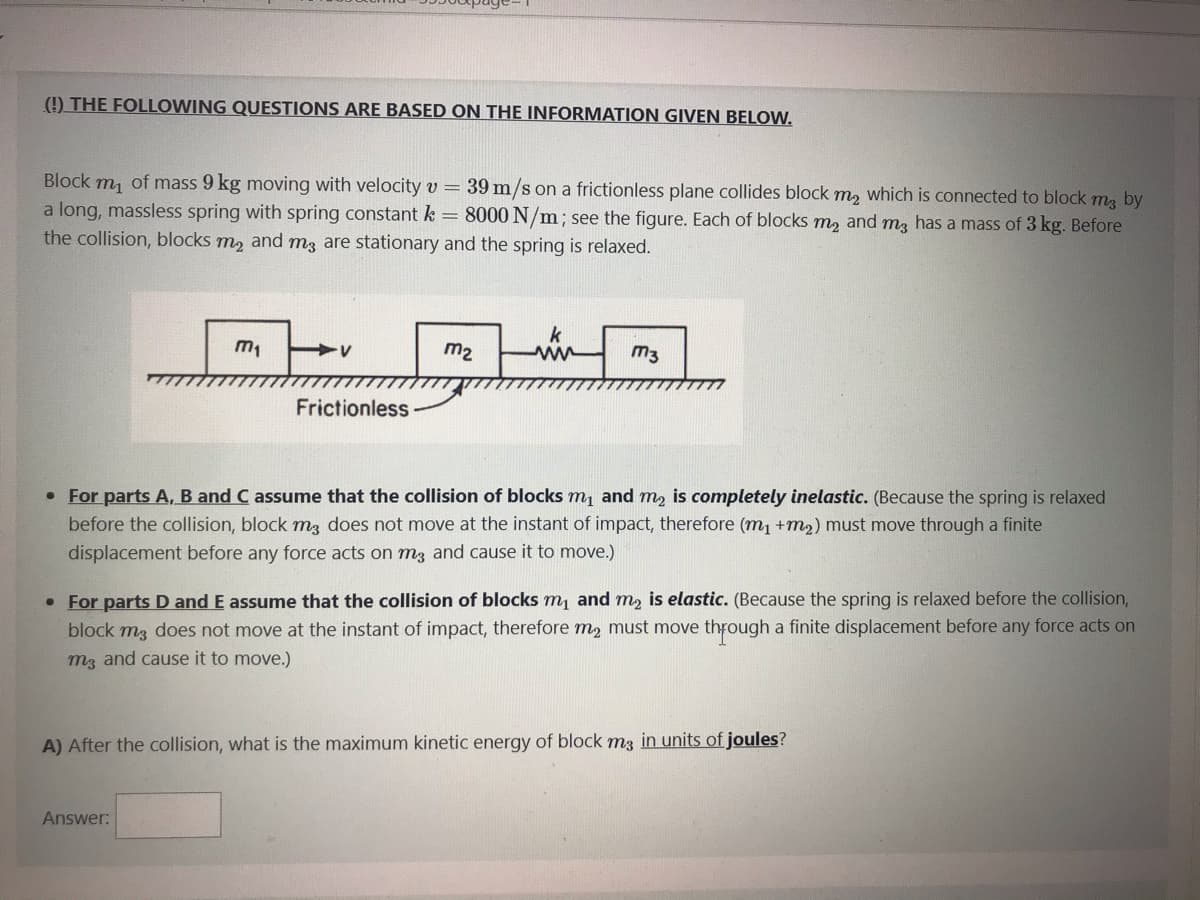() THE FOLLOWING QUESTIONS ARE BASED ON THE INFORMATION GIVEN BELOW. Block of mass 9 kg moving with velocity v = 39 m/s on a frictionless plane collides block m, which is connected to block ma by a long, massless spring with spring constant k = 8000 N/m; see the figure. Each of blocks m2 and mz has a mass of 3 kg. Before the collision, blocks m2 and mz are stationary and the spring is relaxed. k ww m2 m3 Frictionless- • For parts A, B and C assume that the collision of blocks m, and m, is completely inelastic. (Because the spring is relaxed before the collision, block m, does not move at the instant of impact, therefore (m, +m2) must move through a finite displacement before any force acts on m3 and cause it to move.) • For parts D and E assume that the collision of blocks m, and m, is elastic. (Because the spring is relaxed before the collision, block m3 does not move at the instant of impact, therefore m2 must move through a finite displacement before any force acts on m3 and cause it to move.) A) After the collision, what is the maximum kinetic energy of block m3 in units of joules? Answer:
() THE FOLLOWING QUESTIONS ARE BASED ON THE INFORMATION GIVEN BELOW. Block of mass 9 kg moving with velocity v = 39 m/s on a frictionless plane collides block m, which is connected to block ma by a long, massless spring with spring constant k = 8000 N/m; see the figure. Each of blocks m2 and mz has a mass of 3 kg. Before the collision, blocks m2 and mz are stationary and the spring is relaxed. k ww m2 m3 Frictionless- • For parts A, B and C assume that the collision of blocks m, and m, is completely inelastic. (Because the spring is relaxed before the collision, block m, does not move at the instant of impact, therefore (m, +m2) must move through a finite displacement before any force acts on m3 and cause it to move.) • For parts D and E assume that the collision of blocks m, and m, is elastic. (Because the spring is relaxed before the collision, block m3 does not move at the instant of impact, therefore m2 must move through a finite displacement before any force acts on m3 and cause it to move.) A) After the collision, what is the maximum kinetic energy of block m3 in units of joules? Answer:
University Physics Volume 1
18th Edition
ISBN:9781938168277
Author:William Moebs, Samuel J. Ling, Jeff Sanny
Publisher:William Moebs, Samuel J. Ling, Jeff Sanny
Chapter9: Linear Momentum And Collisions
Section: Chapter Questions
Problem 55P: A projectile of mass 2.0 kg is fired in the air at an angle of 40.0 to the horizon at a speed of...
Related questions
Question

Transcribed Image Text:() THE FOLLOWING QUESTIONS ARE BASED ON THE INFORMATION GIVEN BELOW.
Block
of mass 9 kg moving with velocity v = 39 m/s on a frictionless plane collides block m, which is connected to block m, by
a long, massless spring with spring constant k = 8000N/m; see the figure. Each of blocks m, and m3 has a mass of 3 kg. Before
the collision, blocks m, and m3 are stationary and the spring is relaxed.
k
m2
m3
Frictionless
• For parts A, B and C assume that the collision of blocks m, and m, is completely inelastic. (Because the spring is relaxed
before the collision, block m, does not move at the instant of impact, therefore (m1 +m2) must move through a finite
displacement before any force acts on m3 and cause it to move.)
• For parts D and E assume that the collision of blocks m, and m, is elastic. (Because the spring is relaxed before the collision,
block m3 does not move at the instant of impact, therefore m, must move through a finite displacement before any force acts on
m3 and cause it to move.)
A) After the collision, what is the maximum kinetic energy of block m3 in units of joules?
Answer:
Expert Solution
This question has been solved!
Explore an expertly crafted, step-by-step solution for a thorough understanding of key concepts.
Step by step
Solved in 3 steps

Knowledge Booster
Learn more about
Need a deep-dive on the concept behind this application? Look no further. Learn more about this topic, physics and related others by exploring similar questions and additional content below.Recommended textbooks for you

University Physics Volume 1
Physics
ISBN:
9781938168277
Author:
William Moebs, Samuel J. Ling, Jeff Sanny
Publisher:
OpenStax - Rice University

Principles of Physics: A Calculus-Based Text
Physics
ISBN:
9781133104261
Author:
Raymond A. Serway, John W. Jewett
Publisher:
Cengage Learning

Physics for Scientists and Engineers, Technology …
Physics
ISBN:
9781305116399
Author:
Raymond A. Serway, John W. Jewett
Publisher:
Cengage Learning

University Physics Volume 1
Physics
ISBN:
9781938168277
Author:
William Moebs, Samuel J. Ling, Jeff Sanny
Publisher:
OpenStax - Rice University

Principles of Physics: A Calculus-Based Text
Physics
ISBN:
9781133104261
Author:
Raymond A. Serway, John W. Jewett
Publisher:
Cengage Learning

Physics for Scientists and Engineers, Technology …
Physics
ISBN:
9781305116399
Author:
Raymond A. Serway, John W. Jewett
Publisher:
Cengage Learning

Classical Dynamics of Particles and Systems
Physics
ISBN:
9780534408961
Author:
Stephen T. Thornton, Jerry B. Marion
Publisher:
Cengage Learning

Physics for Scientists and Engineers: Foundations…
Physics
ISBN:
9781133939146
Author:
Katz, Debora M.
Publisher:
Cengage Learning

Glencoe Physics: Principles and Problems, Student…
Physics
ISBN:
9780078807213
Author:
Paul W. Zitzewitz
Publisher:
Glencoe/McGraw-Hill